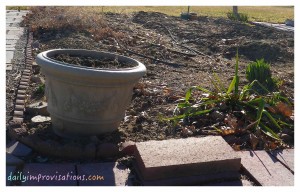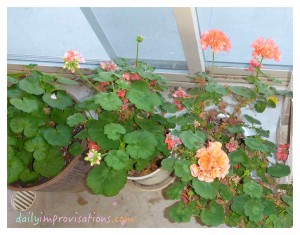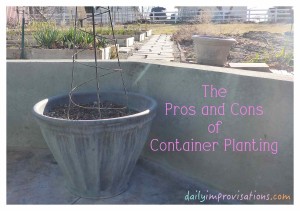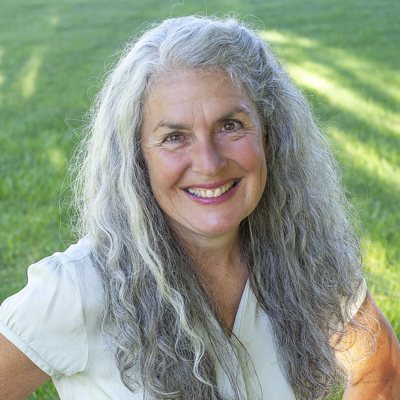I have an acre to plant things on, but I still use containers for some things and in some places outside. That is because there are some aspects of planting in containers that are either useful or otherwise appealing. However, there are specific challenges when growing things in containers. Here is a list of pros and cons that should help with both set up and problem solving along through the seasons. (click on any photo to enlarge)
Pros
1. The most obvious advantage of any type of gardening in a container, whether flowers or vegetables, is the ability to locate plants where a regular garden cannot be planted. Whether it be lack of ground (i.e. upper story apartment), lack of dirt (i.e. permanent cement walkways), or lack of ownership (it just isn’t your yard to dig up), containers overcome this. In short, you can put a container almost anywhere.
2. The nearly opposite advantage is that a container can be a way to grow something that is too invasive for your regular garden, particularly if it spreads by roots, such as mint or bamboo.
3. Sometimes it is a simple matter of proximity. If it is helpful to have something closer at hand, such as herbs while cooking dinner. A pot of something growing may be much more likely to get used if it is just a couple steps away versus 50 feet and a walk through the mud.
4. It is relatively easy to relocate plants growing in pots. If it’s not getting enough sunlight, or it’s in the way, or you need to be able to coddle it more through extremes of heat and cold, a container is usually easy to move, depending on its size. Just try to do it when it is at its driest phase.

5. Containers can be decorative in different ways, adding visual interest to the garden area. Some of the containers themselves are works of art. Having containers adds height to a garden that might otherwise be mostly flat. A well placed pot can camouflage or brighten up a spot.
6. Protection of a plant is often a good reason to plant in pots. Such isolation can keep the plants from ground living pests or digging marauders. Another type of protection is from extremes of weather. A tender perennial can be grown outside in the warm months, but taken to a warm, well-lit winter inside without all the complications of digging things up.
7. Plants in pots can warm up faster in the spring, especially if placed in protected, sunny corners on patios. This can give plants a head start in the growing season.
8. There is usually less of a problem with weeds in containers.
Cons
1. The type of soil used in a container is more important. Although some sorts of plants will grow with minimal amendment in almost type of open dirt, a container magnifies any problems that are soil related. This mostly has to do with water management.
2. For one thing, pots both don’t drain as well as open garden spaces, but if they get too dry it can be very complicated to get them to absorb water again.
3. Along the same lines, it takes more regular and careful attention to how adequately a pot is watered. Over watering is a common problem, but it can be hard to water enough so that plants in pots will grow as robustly as plants in open spaces.
4. It is for this reason that a special potting soil is usually recommended, which is more expensive than regular old dirt.
5. Purchased potting soils often come with a slow release fertilizer, but how long that lasts may vary with time and watering and number of plants involved. After that, it will probably be necessary to add fertilizer with some regularity. Composting or mulching doesn’t work well with potting soil, so this usually means a fertilizer solution or embedded stake. Such fertilization is also recommended when using same potting soil year after year, to avoid the cost or work of replacing it.
6. When initially filling a container with potting soil, it is best to make sure it is at least partially moistened. This makes it much easier to water, because when it is still dry, it tends to shed water that is poured onto it. Be warned that stirring wet potting soil will work your arm muscles.
7. Being in a container makes plants more vulnerable to colder temperatures in the fall or winter, because they are not insulated by surrounding soil the same way. It can also mean that roots that might survive in a regular garden bed will die because of extreme cold during the winter or lack of watering, since pots don’t benefit as much from precipitation.
8. Containers confine the roots of plants, thus limiting their size and making them less stable. Up sizing can only be done so much, since there is transplanting stress or limits in sizes of containers that are practical to work with.
9. Not all types of plants can be grown well in containers. Some plants will rebel at confined roots, or the stresses inherent in such a life. Others will just get too big too soon.
10. Earthworms and other beneficial miniature life that help plants thrive in open soil will have very limited access to soil in containers.
Of course, all gardening has its problem solving. We weigh the advantages and disadvantages to doing things a certain way, then decide what we want to try. If you have a good idea ahead of time what might be going on, you can both avoid problems and be ready for them, making container planting a much better experience!


